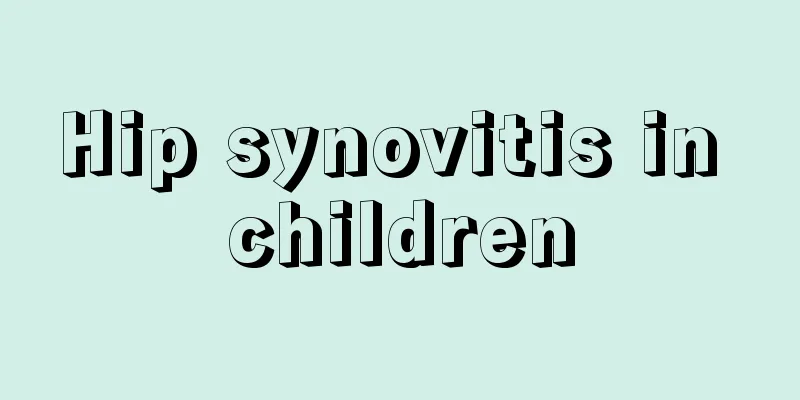Hip synovitis in children

|
Many people don’t know much about the disease phenomenon of synovitis. In fact, synovitis is an important cause of joint diseases. And don’t think that synovitis only occurs in the elderly. In fact, synovitis is also very common in children. There is also synovial membrane around the human hip bone, so some children develop hip synovitis. How should hip synovitis be treated in children? What is synovitis Synovitis is a joint disease in which the synovium is stimulated and becomes inflamed, causing secretion disorders and the formation of effusion. The knee joint has the most synovium in the whole body, so synovitis is most common in the knee. It can be caused by direct violent blow to the knee joint, chronic strain from long-term weight-bearing, indirect knee sprain, injury during surgery, strenuous physical activity or ultra-intensity training, incorrect habitual movements, joint degeneration, knee hyperextension, and even improper wearing of shoes. Traumatic synovium is damaged, synovial congestion and swelling occur, synovial cells actively produce a large amount of effusion, which contains plasma, white blood cells, macrophages, etc. Normal synovial fluid is an alkaline fluid. Due to increased exudation after injury, acidic products accumulate in the joints, and the synovial fluid becomes acidic, which promotes the precipitation of cellulose. If the accumulated fluid is not cleared in time, the synovial membrane of the joint will experience long-term inflammatory stimulation, causing the synovial membrane to gradually thicken and fibrose, causing adhesions and affecting the normal movement of the joints. Synovial cells secrete fluid to lubricate and nourish the joints. The heat energy generated by the knee joint when the body moves is dissipated entirely through the synovial fluid and its blood circulation. When the joints are affected by external and internal factors, the synovium reacts, causing congestion or edema, and exuding fluid, which manifests as joint swelling, pain, and functional impairment. It can also be said that if there is fluid accumulation in the joint cavity, there is synovitis. What are the symptoms of synovitis? Common symptoms: knee edema, pain, limited movement, lameness, limited knee flexion and extension, difficulty squatting, accompanied by pain, localized tenderness around the joint, positive floating patella test 1. First-degree symptoms: The main symptoms are joint pain, with no significant joint swelling or accompanied by mild swelling, a creaking sound when walking, joint pain or discomfort when going up and down stairs or exerting force; the joints feel hot and stiff and the pain is aggravated after walking for a long time. 2. Secondary symptoms: The joints are swollen but not painful. There is discomfort when squatting or bending. Some patients also have muscle atrophy and swelling after excessive exercise. The symptoms are milder in the morning and worsen at night. You cannot walk for a long time, and if you walk too much, your calves will feel sore and swollen, and fluid will increase. 3. Severe symptoms: The joints are swollen and painful, and are accompanied by effusion, bone spurs, and loose bones. 4. Symptoms of bone hyperplasia: Joint pain and significant swelling, more obvious when going up and down stairs, stiffness and inflexibility, with a creaking and popping sound when moving. Patellar softening type: The joints feel sore and weak when walking, and the legs become weak and unable to bend or straighten when running. The pain worsens when walking down stairs and disappears when resting. 5. Meniscus injury type: Legs tend to become weak when walking. Sometimes the legs suddenly become unable to walk, and it feels like something is holding the legs back, and it takes a short rest before things can return to normal. Generally, people who love sports or have special occupations have a higher chance of injury. Sometimes accompanied by atrophy of the thigh muscles. 6. Symptoms of synovitis in children: The affected part of the disease in children is mostly in the hip joint. Children will feel pain when sitting, lying down, exercising, and walking; they will also stand on tiptoe (limp); the onset of the disease is mostly some time after a cold. Parents may not easily detect the disease in the early stages or may misdiagnose it. There is also a special group of people whose symptoms of synovitis appear in the wrist, hip, hip, ankle, and wrist. The symptoms are different from those in other joints, but the pathology is basically the same. |
<<: The child's chest pain will go away after a while.
>>: Two-year-old baby has red bumps all over his body
Recommend
What should I do if my child has dark yellow skin?
Children's skin is generally fairer and smoot...
How to help children improve their memory?
Only by letting children constantly use their bra...
Can mental retardation be cured? Introducing scientific therapy!
The so-called mental retardation usually refers t...
What are the symptoms of pediatric dermatitis?
Nowadays, many children have symptoms of dermatit...
Sharing of baby's development indicators at the age of two
Babies are the fruit of every family's love a...
How to solve the problem of baby not eating pacifier
Many mothers will encounter a distressing phenome...
What to do if your child has a fever and a rash appears on his body
If a child has a fever and a red rash appears on ...
Does it hurt to extract baby teeth?
Dental problems are not age-specific, especially ...
How to treat acute nephritis in children
At present, many children suffer from diseases su...
What are the hazards of excessive lead to children
Although lead is an essential metal element in th...
Is phimosis normal in children? These things you need to know
Phimosis in children is very common in clinical p...
What to do if your child keeps coughing in the middle of the night
If a child keeps coughing in the middle of the ni...
Girl's forehead bone bulge
If a girl has a bony bulge in the middle of her f...
Baby is sleepy after vaccination
Children will have some reactions to varying degr...
How to take care of a child who suddenly has stomach pain
As children grow up day by day, some bad habits w...









